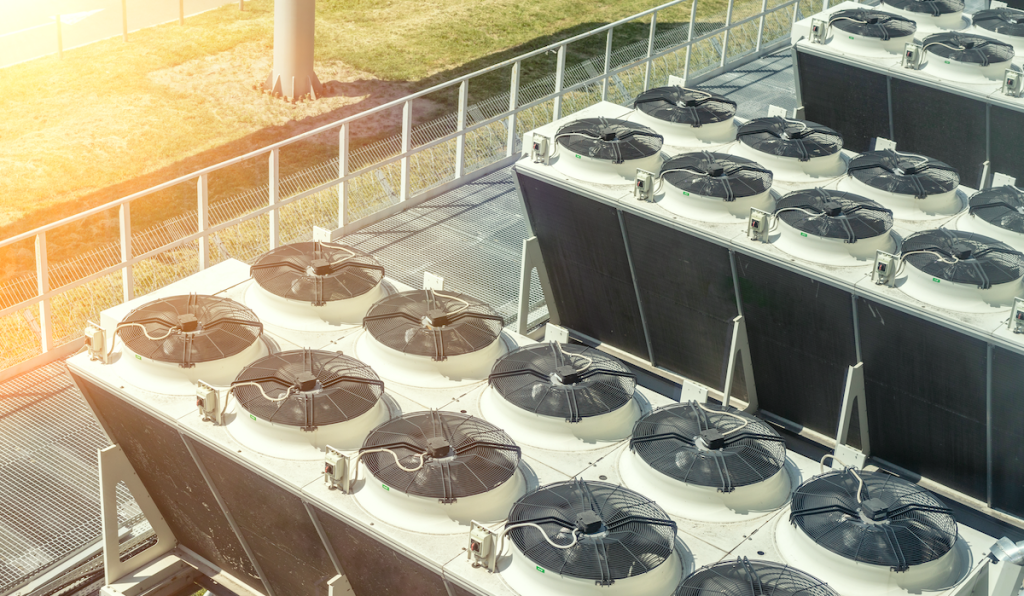In the heart of cooling tower progress, a quiet revolution is underway—one that transcends mere utility and embraces a greener consciousness. Imagine a future where cooling towers, those stalwart structures of temperature regulation, become not just functional elements but beacons of environmental responsibility. Picture a landscape where industries seamlessly integrate sustainability into their core, propelled by the transformative power of how certain sustainable water technologies are leading the way. Focused on the journey of a greener future, where cooling tower water treatment becomes a symbol of innovation, a departure from convention, and a commitment to a sustainable tomorrow.
The integration of Environmental, Social and Governance (ESG) principles with cooling tower mechanics signals a transformative shift in resource management. Cooling towers, beyond their utilitarian role, are now pivotal for weaving environmental consciousness into corporate responsibility. Cooling tower advanced oxidation process (AOP) water treatment exemplifies this evolution, offering a sustainable departure from conventional methods and reinforcing industry commitment to environmental stewardship amid ESG, LEED certification, and water conservation imperatives.
In the nuanced choreography of cooling tower management, a comprehensive understanding of water conservation, regulatory permits, and hidden costs is pivotal. Moving beyond physical structures, this scrutiny extends to the broader ecosystem of compliance, efficiency, and environmental impact. A comparative analysis of chemical versus non-chemical water treatment methods reveals a profound dichotomy with implications for operational efficiency and adherence to ESG principles, underscoring the interplay of technological innovation, corporate responsibility, and environmental consciousness in contemporary cooling tower operations.
ESG & Cooling Towers
The surge of Environmental, Social, and Governance (ESG) principles in how companies are run isn’t just a fancy trend—it’s a game-changer. It’s like companies have decided to step up and make their values count, recognizing that what they do should align with what society needs and what our planet can handle. Enter cooling towers, those big structures you probably didn’t pay much attention to. Now, they’re like the superhero capes of companies, waving the flag for sustainability.
Cooling towers, crucial for keeping things from getting too hot in the commercial buildings and data centers, are now shaping a company’s reputation in the ESG world. It’s not just about keeping things cool anymore; it’s about doing it in a way that’s smart for the environment. Companies are shaking things up, saying goodbye to old-school ways, and diving into innovative technologies that save resources while being kind to the planet.
Hidden Costs of Cooling Towers
Cooling towers are like financial ninjas, quietly racking up costs not visible on balance sheets. Beyond initial setup, they bring a host of hidden expenses—maintenance, unexpected repairs, and the subtle impact of water treatment chemicals draining both budgets and the environment. Factor in the often-overlooked energy consumption and potential fines for environmental non-compliance, and the overall financial impact becomes a silent storm.
Navigating this financial terrain isn’t just about throwing money at the issue; it’s about savvy solutions. Advanced technologies act as financial superheroes, cutting down on chemical use and showing a real commitment to environmental care. Enter the game-changer — cooling tower AOP water treatment, a solution that not only fixes but directly addresses hidden costs. Companies embracing this innovation aren’t just safeguarding their finances; they’re leading the charge in a corporate world that values financial acumen and environmental consciousness.
Leaving a Lighter Footprint
Some companies are even cutting back on chemicals used in these cooling towers. It’s not just about profits; it’s about showing some love to Mother Earth. This reduction in chemical use isn’t just a small detail; it’s a big sign that a company is serious about leaving a lighter footprint. It’s like saying, “We’re in this for the long haul, and we want to be kind to our home.”
But the real frontier in this mix of ESG dreams and cooling tower action is about making things sustainable from top to bottom. It’s not just about keeping things cool; it’s about doing it all in a way that’s good for the planet. Imagine cooling towers going through a metamorphosis, becoming eco-friendly powerhouses. It’s not just a change in how things are cooled; it’s a full-on makeover that includes thinking hard about energy use, waste, and how everything ties into the bigger picture of taking care of our environment.
This cycle of aligning with ESG values and practicing sustainable cooling isn’t just good for the planet; it’s a game-changer for companies. It’s like a secret weapon in their evolution, turning those once-ordinary cooling towers into symbols of responsibility. In a world where companies aren’t just chasing profits but also making sure they keep our environment in check, these cooling towers are standing tall, waving the flag for a new era of corporate responsibility. They’re not just keeping things cool; they’re helping keep the balance in our world.
Water Permits & Compliance
In the complex world of regulations, companies aren’t just dealing with cooling towers; they’re navigating a maze of water permits and environmental laws. As custodians of intricate cooling tower systems, companies must deftly maneuver through a web of regulatory intricacies, securing permits that delineate the parameters for water usage, discharge limits and other environmental benchmarks. These permits transform into legal covenants, shaping the bounds within which cooling tower operations harmonize with ecological preservation. These permits aren’t mere documents; they’re promises guiding companies within the bounds of environmental preservation.
Compliance isn’t a checkbox; it’s a reflection of a company’s commitment to broader principles like Environmental, Social, and Governance (ESG). It’s about using innovative, water-efficient technologies not just to meet rules but to actively design eco-friendly operational strategies. Beyond meeting legal requirements, the infusion of cutting-edge technologies optimizes water utilization and refines treatment methods, transforming companies into architects of ecologically conscious operational blueprints that contribute not only to regulatory compliance but also to the broader agenda of environmental preservation. This delicate balance isn’t just following regulations; it’s about companies shaping a future that’s environmentally conscious and responsible. It’s not reacting to laws; it’s about proactively architecting a greener tomorrow.
Chemical vs. Non-Chemical Water Treatment
It’s not just about chemicals and formulas; it’s a choice that impacts our environment. Traditional methods, with their biocides and inhibitors, might get the job done, but they’re like a double-edged sword, posing risks to water quality and the delicate balance of ecosystems. Think about it—effective against microbes but leaving a lasting mark on our aquatic environments. It’s a real puzzle for industries trying to juggle efficiency and environmental responsibility.
Now, imagine a contrasting method—an approach that doesn’t rely on chemicals. Think of alternative options and physical methods stepping into the scene. It’s like stepping into a new era, where we treat water without introducing potentially harmful substances. Alternative options, such as cooling tower AOP water treatment, goes a step further, using oxidants to break down contaminants at a molecular level. It’s not just a technological leap; it’s a hug to environmental stewardship, aligning perfectly with principles like Environmental, Social, and Governance (ESG).
As industries navigate the maze of water treatment options, the choice between chemicals and non-chemical methods becomes a big deal. It’s a moment where we weigh operational needs against preserving our ecosystems. The journey toward sustainable cooling tower water treatment isn’t just a technical one; it’s about making smart decisions that commit to a future where efficiency walks hand in hand with environmental sustainability.
LEED Certification and Water Conservation
Understanding LEED Certification
LEED, or Leadership in Energy and Environmental Design, is a globally recognized certification program that assesses the environmental performance of buildings and encourages sustainable practices. When it comes to cooling towers, achieving LEED certification involves integrating environmentally friendly features and operational practices that contribute to energy efficiency and overall sustainability.
Key Aspects of LEED Certification in Cooling Towers:
- Water Efficiency: LEED places a significant emphasis on water conservation. In the context of cooling towers, this translates to implementing technologies and strategies that minimize water consumption while maintaining optimal performance. Water-efficient systems, recycling, and reuse mechanisms are key components contributing to LEED points.
- Innovation in Design: LEED encourages innovative approaches that go beyond standard practices. In cooling tower design, incorporating features like cooling tower AOP water treatment technologies, smart water monitoring systems, and sustainable materials contributes to LEED points.
- Energy Performance: While not directly related to water, energy efficiency is another critical aspect of LEED certification. Since cooling towers are energy-intensive, optimizing their performance to reduce energy consumption is integral to LEED compliance.
Water Conservation Strategies in Cooling Towers:
Cooling towers are notorious for their significant water consumption, making water conservation strategies crucial for sustainability. Implementing effective water conservation practices not only aligns with LEED objectives but also reflects a commitment to responsible water stewardship.
Key Water Conservation Strategies in Cooling Towers:
- Water Recycling and Reuse: Implementing systems that recycle and reuse water within cooling tower operations is a primary strategy. This not only reduces the demand for freshwater but also minimizes wastewater discharge, aligning with both water conservation goals and LEED certification criteria.
- Optimized Water Treatment Technologies: Choosing advanced water treatment technologies, such as non-chemical methods like cooling tower AOP water treatment, can significantly reduce the need for traditional chemical treatments. This not only enhances water quality but also contributes to water conservation efforts.
- Smart Water Management Systems: Integrating intelligent water management systems allows for real-time monitoring and optimization of water usage. This proactive approach helps identify inefficiencies and allows for adjustments to minimize water consumption.
- Regular Maintenance and Inspections: Ensuring cooling towers are well-maintained and regularly inspected helps identify and fix leaks or inefficiencies promptly. This proactive maintenance approach not only contributes to water conservation but also supports the longevity and efficiency of cooling tower operations.
The Intersection of LEED & Water Conservation:
In the realm of cooling towers, LEED certification and water conservation are intricately linked. Achieving LEED certification requires a holistic approach that considers not only energy efficiency but also water conservation practices. By implementing innovative technologies, optimizing operational processes, and embracing a commitment to sustainable water usage, companies can not only enhance their ESG profiles but also contribute to a greener, more responsible industrial landscape. LEED certification becomes not just a badge of honor but a testament to a company’s dedication to both environmental and water stewardship in cooling tower operations.
LEED Certification for a Sustainable World
In the world of sustainability, snagging a Leadership in Energy and Environmental Design (LEED) certification is like winning an Oscar for being eco-friendly. It’s not just about building stuff; it’s about building stuff in a way that screams, “Hey, we’re committed to taking care of our planet!”
LEED certification isn’t your average gold star; it’s the gold standard for proving that a company or building is seriously dedicated to being green. It’s not only about making a place look pretty; it’s about making it work in a way that’s kind to the environment. And guess what? Cooling towers, those giant structures that help keep things chill in big buildings, aren’t just there to do their job; they’re turning into heroes of sustainability.
When you combine these cooling towers with super cool water-saving systems, they become champions of innovation. They don’t just sit there; they actively contribute to a building’s LEED score, especially when it comes to saving water. It’s not just about being a part of the structure; these towers are integral in getting that top-notch LEED rating, especially in the water conservation department.
The Power Team
Now, the real magic happens when you bring water conservation and LEED together. It’s like they’re a power couple in the world of responsible construction. Cooling towers and water conservation team up within the LEED framework, sending a powerful message that being eco-friendly isn’t just a trend—it’s a way of life.
Reducing environmental impact isn’t just a side gig; it’s the main event. Pairing up water-efficient systems with these towering cooling structures isn’t just smart—it’s necessary. It’s about making sure the way we build doesn’t just look good but does good for the planet. As companies jump on board with the LEED vibe, figuring out how to use water in these towers becomes a big deal in the story of sustainable development.
This whole mix of being smart about operations and caring for the environment is what LEED certification is all about. It’s not just a stamp of approval for being efficient; it’s a solid commitment to creating a world where buildings aren’t just structures but part of a bigger plan for a sustainable future.
Cooling Tower AOP Water Treatment: A Sustainable Approach
Cooling tower AOP water treatment is gaining popularity when it comes to these issues as the solution to a sustainable alternative to traditional chemical water treatment methods. AOP water treatment stands as an avant-garde luminary, orchestrating a departure from conventional paradigms toward a realm where sustainability and efficacy converge.
Unlike traditional chemical water treatment methods that often introduce reactive agents with potential environmental consequences, cooling tower AOP water treatment leverages a sophisticated interplay of hydroxyl radicals, powerful oxidants to dismantle contaminants at their molecular core. Hydroxyl radical effectiveness comes from creating powerful reactive substances, going beyond the usual choice between effectiveness and sustainability. It transforms into a symbol of precision, targeting contaminants selectively and avoiding the environmental issues linked to chemical alternatives.
This precision engineering not only amplifies the technological process of cooling tower AOP water treatment but positions it as a sustainable water management practice.
The rise of cooling tower AOP water treatment is linked to ESG principles, emphasizing Environmental, Social, and Governance factors. AOP plays a crucial role in promoting sustainable water treatment by reducing reliance on chemicals and aligning with environmental responsibility. It goes beyond compliance, actively contributing to improved water quality and a more eco-friendly impact from cooling tower operations. As industries focus more on ESG, AOP represents a shift where water treatment signifies environmental consciousness and sustainable industrial practices, marking a paradigm change beyond just technological advancement.
Water Conservation Strategies for Cooling Towers
Sustainable cooling tower operation and water conservation play a crucial role in balancing industrial functionality with environmental responsibility. Utilizing water-efficient technologies helps reduce the excessive water consumption of cooling towers. Water recycling and reuse systems break the linear pattern of water usage, decreasing the need for freshwater and lessening environmental impact. As industries commit to Environmental, Social, and Governance (ESG) goals, implementing water conservation strategies goes beyond regulatory compliance, becoming a symbolic commitment to responsible water stewardship. This positions water conservation at the forefront, showcasing where sustainability and operational efficiency work together seamlessly. Considerations such as LEED certification, water conservation, permits, hidden costs, and the choice between chemical and non-chemical treatment methods all play a role in this concerted effort toward responsible and environmentally friendly cooling tower operation.







